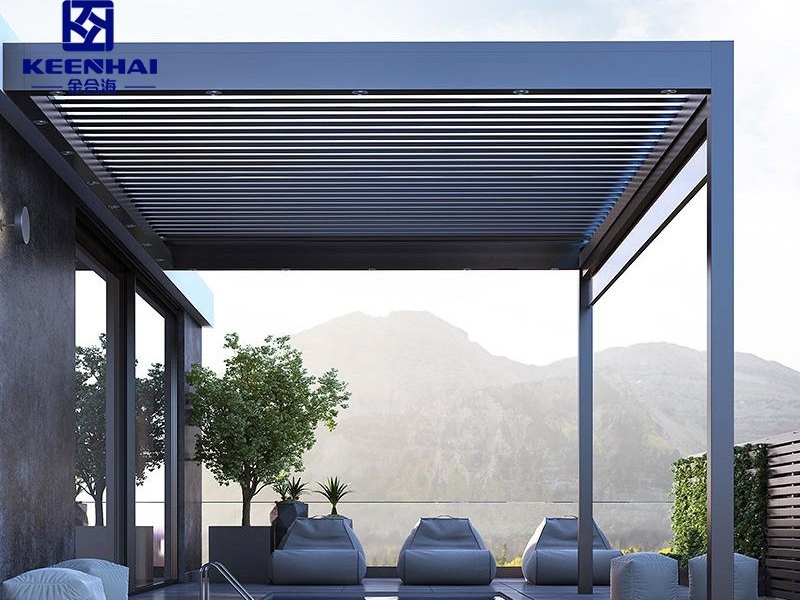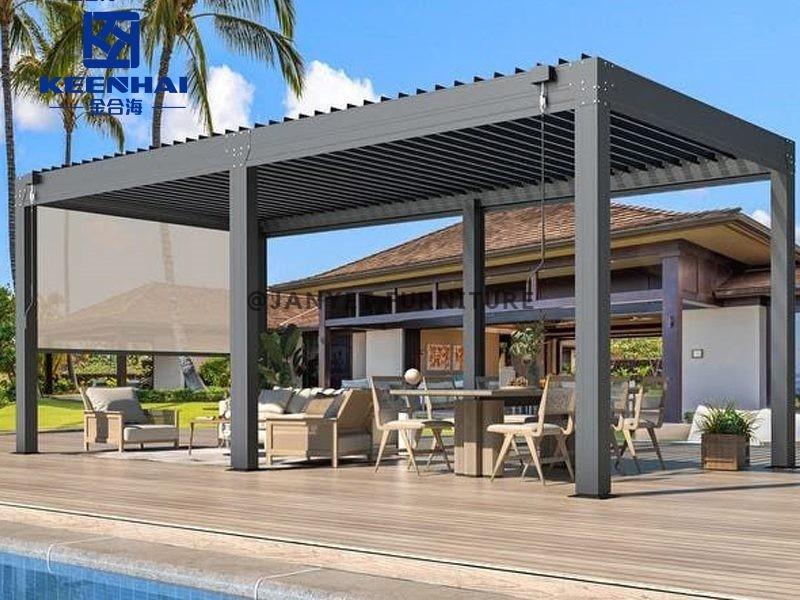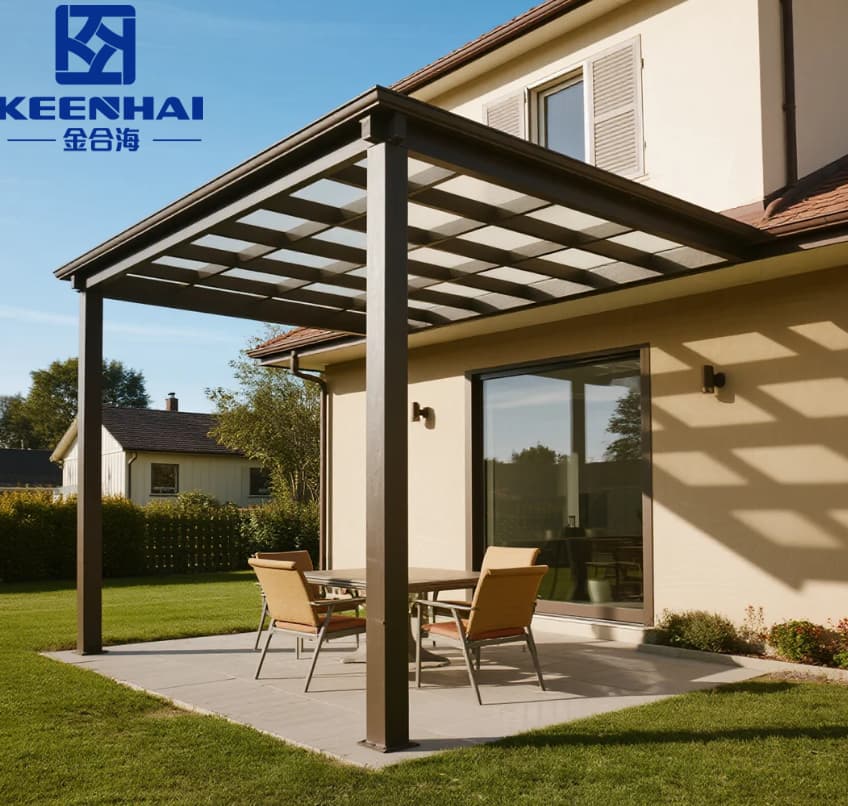
Design and Aesthetics
Visual Appeal in Outdoor Spaces
When you walk into your backyard, what you see first sets the mood for the entire space. A Garden Pergola instantly brings structure and elegance, creating an inviting atmosphere where flowers and climbing plants can thrive. On a patio, a Patio Pergola turns a plain slab into a stylish outdoor living area, perfect for lounging, dining, or hosting friends.
Imagine this scenario: you place a sleek aluminum pergola near your vegetable garden, then train jasmine and roses to climb its frame. In the morning, sunlight filters through the plants, creating natural patterns on the ground. The combination of structure and greenery feels deliberate, yet effortless, providing both shade and visual depth.
Customization Options
Customization is where pergolas truly shine. A Custom Aluminum Pergola lets you tailor size, height, and roof style to fit your exact outdoor needs. Here’s how homeowners usually approach customization:
-
Measure the space – Determine length, width, and height for optimal flow.
-
Select roof type – Choose between fixed panels, retractable fabric, or louvred roofs for adjustable light.
-
Choose materials and colors – Aluminum for low maintenance, wood for a warmer feel, or a combination for style contrasts.
-
Add finishing touches – Incorporate integrated lighting, side panels, or climbing plant supports.
For example, a courtyard with limited space benefits from a smaller Garden Pergola with partial overhead coverage, while a 16x12 ft patio area can handle a full louvred Patio Pergola that controls sunlight and airflow with precision. Every choice in customization enhances usability and aesthetic appeal simultaneously.
Material Choices and Finishes
Material selection directly impacts both the look and durability of a pergola. Aluminum frames offer strength, weather resistance, and low maintenance, making them ideal for modern patios or garden settings. Wood brings warmth and natural charm, but you must commit to periodic staining or sealing to prevent weather damage.
Here’s a quick comparison of common pergola materials:
| Material | Durability | Maintenance | Visual Impact |
|---|---|---|---|
| Aluminum | Very high | Low | Sleek, contemporary |
| Wood | Medium | Medium-High | Warm, natural, classic |
| Composite | High | Medium | Varied, customizable |
Consider this practical example: a backyard owner installs a Louvres Pergola over their patio. The adjustable louvers let them block afternoon sun during summer, but still allow light in during morning and evening hours. The aluminum frame resists rust and keeps a sharp appearance year after year, minimizing maintenance effort.

Functionality and Use Cases
Garden Pergola: Enhancing Gardens and Greenery
A Garden Pergola focuses on beautifying your garden while creating intimate, shaded spaces. It works perfectly along walkways, flower beds, or small lawns. Imagine walking along a stone path framed by climbing roses and jasmine, with a pergola overhead offering both shade and structure.
Homeowners often maximize its functionality by:
-
Positioning it in key garden spots where plants can climb naturally.
-
Adding benches or swings underneath for relaxing moments.
-
Integrating subtle lighting to highlight flowers and plants in the evening.
Patio Pergola: Expanding Outdoor Living Areas
Patio Pergolas aim to extend your indoor living space outdoors. They provide shelter and comfort for dining, lounging, or social gatherings. Picture a family enjoying brunch under a louvered patio pergola while sunlight filters through the adjustable slats.
Typical steps to set up an effective Patio Pergola:
-
Determine the main activity area—dining, lounge, or BBQ.
-
Choose adjustable or louvered roofs to control sun and airflow.
-
Add functional features like retractable screens, fans, or heaters.
Versatility for Entertaining and Relaxation
Both pergola types can be multi-functional, but their strengths differ. Garden Pergolas excel at visual appeal and serene retreats, while Patio Pergolas handle social activities and outdoor living comfort.
Here’s a clear comparison:
| Feature / Use Case | Garden Pergola | Patio Pergola |
|---|---|---|
| Primary Purpose | Beautifying gardens, supporting plants | Extending living and entertaining areas |
| Ideal Location | Flower beds, pathways, small lawns | Decks, patios, open backyard spaces |
| Seating & Relaxation Options | Benches, swings, small seating nooks | Dining tables, lounge furniture, sectional seating |
| Sun & Shade Control | Partial shade, filtered light through plants | Adjustable louvers or fixed roof for controlled shade |
| Social & Entertainment | Light, intimate gatherings | Hosting parties, BBQs, or family meals |
| Design Flexibility | Often smaller, decorative | Larger footprint, functional design |
Scenario: A homeowner places a Garden Pergola along their garden pathway for quiet reading and plant support. Later, they install a louvered Patio Pergola over a patio for weekend BBQs and family gatherings. This combination provides both serene garden retreats and functional outdoor living zones, showing how each type complements different needs.

Durability and Maintenance
Weather Resistance and Longevity
A pergola is only as good as its ability to withstand the elements. Aluminum pergolas resist rust and fading, making them ideal for sunny or rainy climates, while wood delivers natural charm but demands careful protection. Imagine installing a patio pergola near a pool: after a summer of bright sun and occasional rainstorms, the aluminum frame still looks pristine, whereas untreated wood would need sanding and resealing to maintain its appearance.
Key steps to maximize durability:
-
Select high-quality materials designed for your local climate.
-
Ensure proper anchoring to prevent wind damage, especially in open patios.
-
Inspect connections periodically for signs of loosening or corrosion.
-
Apply protective coatings on wood annually to prolong life.
Real-world example: A homeowner in Florida installed a powder-coated aluminum louvers pergola over a deck. After three hurricane seasons, the structure remained stable and visually sharp, allowing them to continue hosting outdoor gatherings without worry.
Cleaning and Upkeep Requirements
Maintenance doesn’t have to be complicated, but consistency matters. Aluminum pergolas require minimal effort—usually a quick rinse with water every few months. Wood structures need more attention to prevent warping or decay. Here’s a typical maintenance routine for wood or mixed-material pergolas:
-
Remove debris and leaves from the roof and support beams monthly.
-
Wash with mild detergent and water every quarter to remove dirt or pollen buildup.
-
Apply stain or sealant annually to protect wood from moisture and UV damage.
-
Check hardware like screws and brackets for rust or loosening, tightening as needed.
Scenario: A family in Seattle set up a garden pergola along their flower beds. By following this routine, they kept the structure looking fresh throughout the rainy season while also ensuring safety and stability.
Material Comparison: Aluminum, Wood, and Others
Material choice impacts both durability and maintenance. Here’s a straightforward comparison:
| Material | Weather Resistance | Maintenance Effort | Longevity | Visual Appeal |
|---|---|---|---|---|
| Aluminum | Very high | Low | 20+ years | Sleek, modern |
| Wood | Medium | High | 10–15 years | Warm, natural |
| Composite | High | Medium | 15–20 years | Varied finishes |
For example, a homeowner installing a Louvres Pergola over a patio in Arizona chose aluminum with a powder-coated finish. Even after months of intense sun, the color stayed vibrant and the louvers functioned smoothly, showing that investing in the right material significantly reduces maintenance headaches.

Cost and Value Considerations
Initial Investment Comparison
When planning a pergola, budgeting upfront is key. Garden Pergolas typically require less material and labor, making them a more cost-effective choice for small yards. Patio Pergolas, especially those with louvres or retractable roofs, demand sturdier frames and more precise installation.
Consider this scenario: a homeowner wants to add a 12x10 ft structure. They can:
-
Opt for a basic wooden Garden Pergola along a flower bed, costing around $1,500–$2,000 including installation.
-
Choose a 12x16 ft aluminum Patio Pergola with adjustable louvres, costing $4,500–$6,000 due to material quality and installation complexity.
This comparison shows that size, material, and roof type directly impact initial investment, so aligning your choice with your intended use is crucial.
Long-Term Value and ROI
Investing in the right pergola pays off over time. Aluminum structures retain their appearance and require minimal maintenance, reducing long-term costs. Wooden options, while visually warm, may need yearly staining and occasional repairs, adding hidden expenses.
Real-life example: A family installed a powder-coated aluminum Patio Pergola over a dining area. Over five years, they spent less than $100 on maintenance, compared to a neighboring wood pergola that needed $600 in upkeep. This shows that initially higher costs can result in better ROI when durability and maintenance are considered.
Installation Complexity and Expenses
Installation isn’t just about cost—it’s about convenience and longevity. Here’s a step-by-step outline for typical pergola installation:
-
Site preparation – level the ground, remove obstacles, and mark foundation points.
-
Anchor posts – secure vertical supports to ensure stability against wind or uneven terrain.
-
Assemble the frame – attach beams and crossbars according to manufacturer specifications.
-
Install roof panels – fixed, retractable, or louvred depending on the design.
-
Final adjustments – tighten all bolts, check level, and add optional features like lighting or side panels.
| Feature | Garden Pergola | Patio Pergola |
|---|---|---|
| Installation Difficulty | Medium | High |
| Required Labor | 1–2 days | 3–5 days |
| Material Handling | Light | Heavy |
| Tools & Equipment Needed | Basic | Specialized |
For example, a homeowner installing a Custom Aluminum Pergola over a backyard patio noticed that careful anchoring and proper alignment of louvers were crucial to ensure smooth operation and long-term stability. Skipping any step could lead to uneven panels or operational issues, so precision matters.
